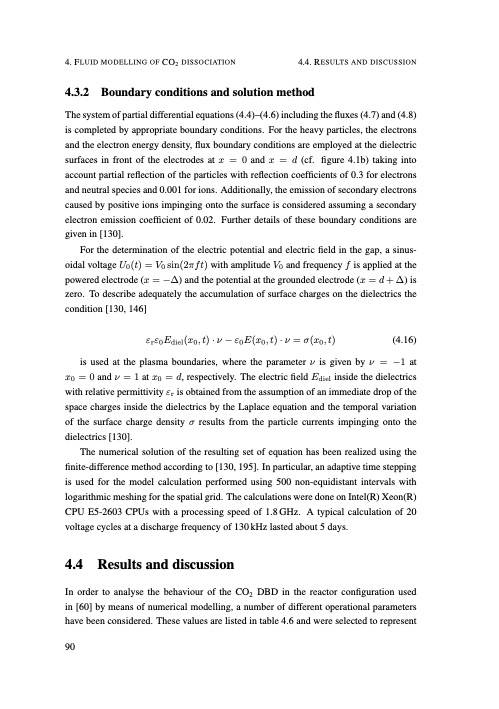
PDF Publication Title:
Text from PDF Page: 099
4. FLUID MODELLING OF CO2 DISSOCIATION 4.4. RESULTS AND DISCUSSION 4.3.2 Boundary conditions and solution method The system of partial differential equations (4.4)–(4.6) including the fluxes (4.7) and (4.8) is completed by appropriate boundary conditions. For the heavy particles, the electrons and the electron energy density, flux boundary conditions are employed at the dielectric surfaces in front of the electrodes at x = 0 and x = d (cf. figure 4.1b) taking into account partial reflection of the particles with reflection coefficients of 0.3 for electrons and neutral species and 0.001 for ions. Additionally, the emission of secondary electrons caused by positive ions impinging onto the surface is considered assuming a secondary electron emission coefficient of 0.02. Further details of these boundary conditions are given in [130]. For the determination of the electric potential and electric field in the gap, a sinus- oidal voltage U0(t) = V0 sin(2πft) with amplitude V0 and frequency f is applied at the powered electrode (x = −∆) and the potential at the grounded electrode (x = d + ∆) is zero. To describe adequately the accumulation of surface charges on the dielectrics the condition [130, 146] εrε0Ediel(x0, t) · ν − ε0E(x0, t) · ν = σ(x0, t) (4.16) is used at the plasma boundaries, where the parameter ν is given by ν = −1 at x0 = 0 and ν = 1 at x0 = d, respectively. The electric field Ediel inside the dielectrics with relative permittivity εr is obtained from the assumption of an immediate drop of the space charges inside the dielectrics by the Laplace equation and the temporal variation of the surface charge density σ results from the particle currents impinging onto the dielectrics [130]. The numerical solution of the resulting set of equation has been realized using the finite-difference method according to [130, 195]. In particular, an adaptive time stepping is used for the model calculation performed using 500 non-equidistant intervals with logarithmic meshing for the spatial grid. The calculations were done on Intel(R) Xeon(R) CPU E5-2603 CPUs with a processing speed of 1.8 GHz. A typical calculation of 20 voltage cycles at a discharge frequency of 130 kHz lasted about 5 days. 4.4 Results and discussion In order to analyse the behaviour of the CO2 DBD in the reactor configuration used in [60] by means of numerical modelling, a number of different operational parameters have been considered. These values are listed in table 4.6 and were selected to represent 90PDF Image | Understanding CO2 containing non-equilibrium plasmas

PDF Search Title:
Understanding CO2 containing non-equilibrium plasmasOriginal File Name Searched:
20160125_CO_Ponduri.pdfDIY PDF Search: Google It | Yahoo | Bing
NFT (Non Fungible Token): Buy our tech, design, development or system NFT and become part of our tech NFT network... More Info
IT XR Project Redstone NFT Available for Sale: NFT for high tech turbine design with one part 3D printed counter-rotating energy turbine. Be part of the future with this NFT. Can be bought and sold but only one design NFT exists. Royalties go to the developer (Infinity) to keep enhancing design and applications... More Info
Infinity Turbine IT XR Project Redstone Design: NFT for sale... NFT for high tech turbine design with one part 3D printed counter-rotating energy turbine. Includes all rights to this turbine design, including license for Fluid Handling Block I and II for the turbine assembly and housing. The NFT includes the blueprints (cad/cam), revenue streams, and all future development of the IT XR Project Redstone... More Info
Infinity Turbine ROT Radial Outflow Turbine 24 Design and Worldwide Rights: NFT for sale... NFT for the ROT 24 energy turbine. Be part of the future with this NFT. This design can be bought and sold but only one design NFT exists. You may manufacture the unit, or get the revenues from its sale from Infinity Turbine. Royalties go to the developer (Infinity) to keep enhancing design and applications... More Info
Infinity Supercritical CO2 10 Liter Extractor Design and Worldwide Rights: The Infinity Supercritical 10L CO2 extractor is for botanical oil extraction, which is rich in terpenes and can produce shelf ready full spectrum oil. With over 5 years of development, this industry leader mature extractor machine has been sold since 2015 and is part of many profitable businesses. The process can also be used for electrowinning, e-waste recycling, and lithium battery recycling, gold mining electronic wastes, precious metals. CO2 can also be used in a reverse fuel cell with nafion to make a gas-to-liquids fuel, such as methanol, ethanol and butanol or ethylene. Supercritical CO2 has also been used for treating nafion to make it more effective catalyst. This NFT is for the purchase of worldwide rights which includes the design. More Info
NFT (Non Fungible Token): Buy our tech, design, development or system NFT and become part of our tech NFT network... More Info
Infinity Turbine Products: Special for this month, any plans are $10,000 for complete Cad/Cam blueprints. License is for one build. Try before you buy a production license. May pay by Bitcoin or other Crypto. Products Page... More Info
| CONTACT TEL: 608-238-6001 Email: greg@infinityturbine.com | RSS | AMP |